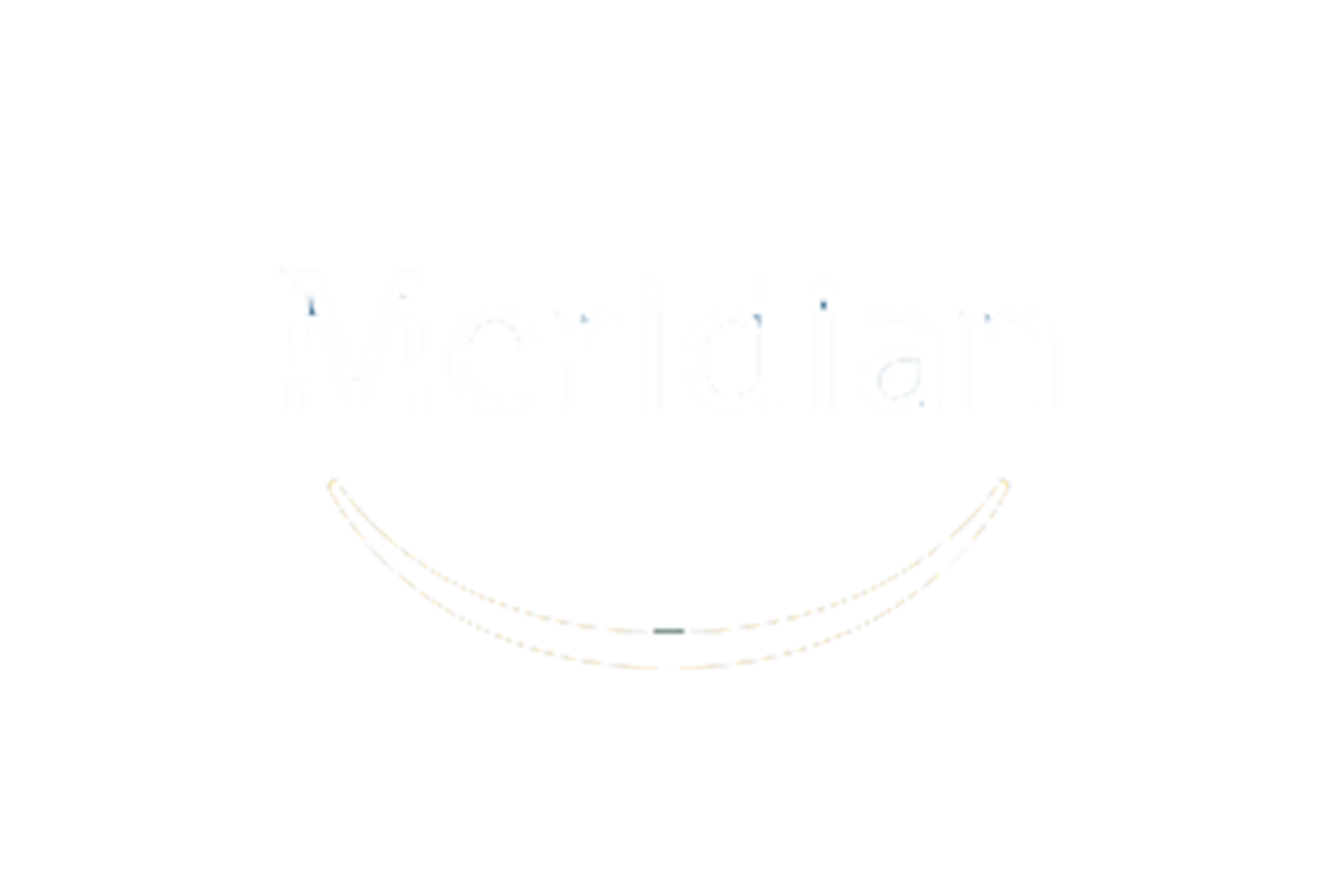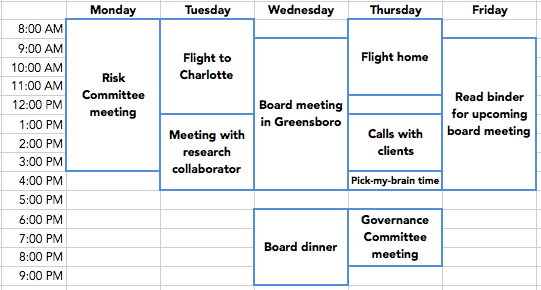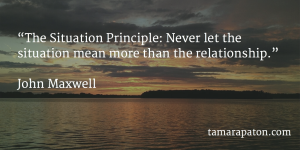

When we think about what we value highly, most of us rank time near the top of our list. I don’t know anyone who feels like they have too much time on their hands.
Because I have a somewhat unusual day job, sometimes I’m asked to describe my typical week. Every week is different, but my calendar recently looked like this:
In between meetings, I tackled other important, but not necessarily urgent, activities. For example, I submitted my CV for two potential board opportunities, scheduled a one-on-one meeting with a colleague, and spoke with contacts in my network for one hour.
Taking time for tomorrow, in addition to today’s to-do list, is the only way I will string together a career that lasts.
My clients often say that they could give two or three days per month to a board appointment. The timing of when that commitment begins may surprise you. If you think you can start investing that time after being elected to a board, you may never reach your goal.
We have an opportunity to carve out resources for our board career right now. If you have two days per month available for board work, intentionally invest 15-20 hours this month in board-related training and networking. Consistently keeping these commitments to yourself makes you a pilot, rather than a passenger, en route to success.
With your calendar blocked appropriately, these activities will position you for optimal impact:
1. One-on-one meetings
One of my clients recently summarized the network-building activities she had underway. As she reviewed her list, I was impressed with her commitment, but noticed a consistent theme. This self-declared introvert was building her network via email, phone calls, blogging and independent research. For all I knew, she was pursuing a board career while sporting her most comfortable pajamas. It was time for her to get out in the world and see people face-to-face.
Aside from the occasional conference call, board service is an in-person activity. See my recent post to make the most of one-on-one interactions that mark your path to a board seat.
Set a target: Each month, I aim to have two one-on-one meetings with new contacts. You might manage even more. The number isn’t as important as the habit of connecting and reconnecting without an explicit agenda.
2. “Palm up” networking
Leadership expert Christine Comaford encourages us to build relationships by doing favors. By sharing our knowledge and networks, we become known for knowing something and our willingness to help others. This recent post highlighted ways that generosity can bring you closer to your board goals.
Set a target: Set aside a window of time each week to share your knowledge and contacts with others. I reserve an hour for 15-minute “pick my brain” phone calls and emails. If I’m lucky, I squeeze in an opportunity to introduce people by email during that time. When consistently practiced, this investment can yield enormous benefit over months and years.
3. Investing in professional development and thought leadership
I often stress the importance of being known for knowing something (see here, here and here). Investing in your knowledge is half the battle. Building awareness of your gifts begins with generous networking. In addition, my own blogging habit indicates the value I place on writing in one’s area of expertise.
Set a target: Draw up a list of the strengths and knowledge gaps you would like to address. Research available courses, books and volunteer experiences that align with your development needs. Schedule the development activities you will pursue over the next 12 months. Ideally, you will always be working on something, even if only for one hour per week.
4. Building your marketing toolkit
Once you have someone’s attention, your CV, LinkedIn profile and interview skills determine your trajectory. Just as big brands have marketing collateral, social media campaigns and public relations strategy, corporate directors should have their own marketing toolkit at the ready.
Set a target: Refresh your CV every three months. You can improve your LinkedIn presence more often by sharing an interesting article or commenting on a half-dozen status updates. To keep your interview skills sharp, I recommend interviewing – even if only in simulation – at least once per quarter.
(Side note: My “Ace the Interview” coaching package makes this easy. And I cover the entire marketing toolkit in my upcoming launch of The Boardroom Blueprint online program.)
Admittedly, these ideas are not rocket science. What makes them powerful is their consistent application.
If you are already overwhelmed, consider adding just one practice to your routine. Once it becomes second nature, add another. The results that you’ll see will motivate you to apply these and other techniques en route to the boardroom.
Question: What efficiency and effectiveness hacks do you use to leverage your time? I would love to hear your thoughts via Twitter.









